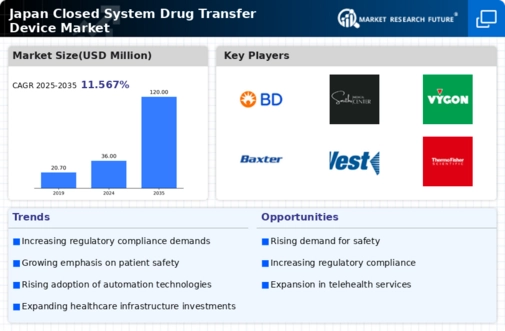Rising Demand for Safety Protocols
The increasing emphasis on safety protocols within healthcare settings is driving the closed system-drug-transfer-device market. In Japan, healthcare facilities are prioritizing the protection of healthcare workers from hazardous drug exposure. This trend is reflected in the adoption of closed system-drug-transfer devices, which are designed to minimize the risk of contamination and exposure. As a result, the market is projected to grow at a CAGR of approximately 8% over the next five years. The heightened awareness of occupational safety is likely to propel investments in advanced drug transfer technologies, thereby enhancing the overall market landscape.
Focus on Infection Control Measures
The heightened focus on infection control measures within healthcare facilities is driving the closed system-drug-transfer-device market. In Japan, hospitals are increasingly adopting stringent protocols to prevent healthcare-associated infections, which has led to a surge in the use of closed system-drug-transfer devices. These devices are designed to reduce the risk of contamination during drug preparation and administration. The market is projected to grow at a rate of approximately 7% as healthcare providers recognize the importance of infection control in enhancing patient outcomes. This trend underscores the critical role of closed system-drug-transfer devices in maintaining high standards of safety in healthcare.
Technological Integration in Healthcare
The integration of advanced technologies in healthcare is a key driver for the closed system-drug-transfer-device market. In Japan, the rise of automation and digital solutions in medical practices is fostering the adoption of sophisticated drug transfer systems. These devices are increasingly equipped with features such as real-time monitoring and data analytics, which enhance their functionality and safety. The market is projected to expand by approximately 9% as healthcare facilities seek to leverage technology for improved efficiency and safety in drug handling. This trend indicates a shift towards more reliable and efficient healthcare delivery systems.
Aging Population and Increased Healthcare Needs
Japan's aging population is contributing to the growing demand for healthcare services, thereby impacting the closed system-drug-transfer-device market. As the elderly population increases, there is a corresponding rise in the need for safe and effective drug administration methods. The market is expected to grow by about 6% as healthcare providers seek to accommodate the complex medication regimens often required by older patients. This demographic shift necessitates the implementation of closed system-drug-transfer devices to ensure safety and efficacy in drug delivery, highlighting the importance of these devices in modern healthcare.
Government Initiatives for Healthcare Improvement
Government initiatives aimed at improving healthcare quality and safety are significantly influencing the closed system-drug-transfer-device market. In Japan, the Ministry of Health, Labour and Welfare has implemented various programs to promote the use of safer drug handling practices. These initiatives are expected to increase the adoption of closed system-drug-transfer devices across hospitals and clinics. The market is anticipated to witness a growth rate of around 7% as healthcare providers align with these government mandates. Such policies not only enhance patient safety but also encourage the integration of innovative technologies in drug administration.





















Leave a Comment